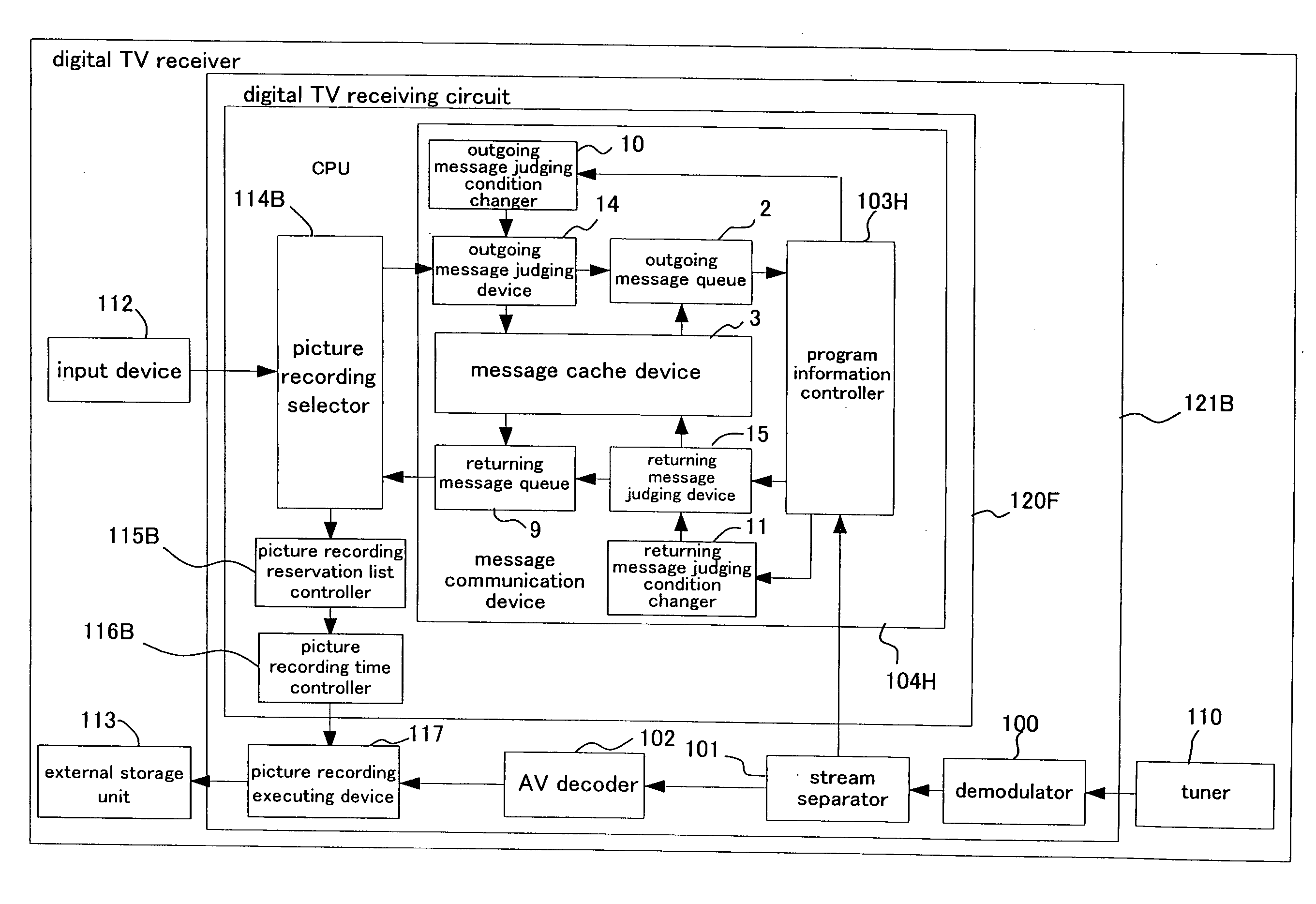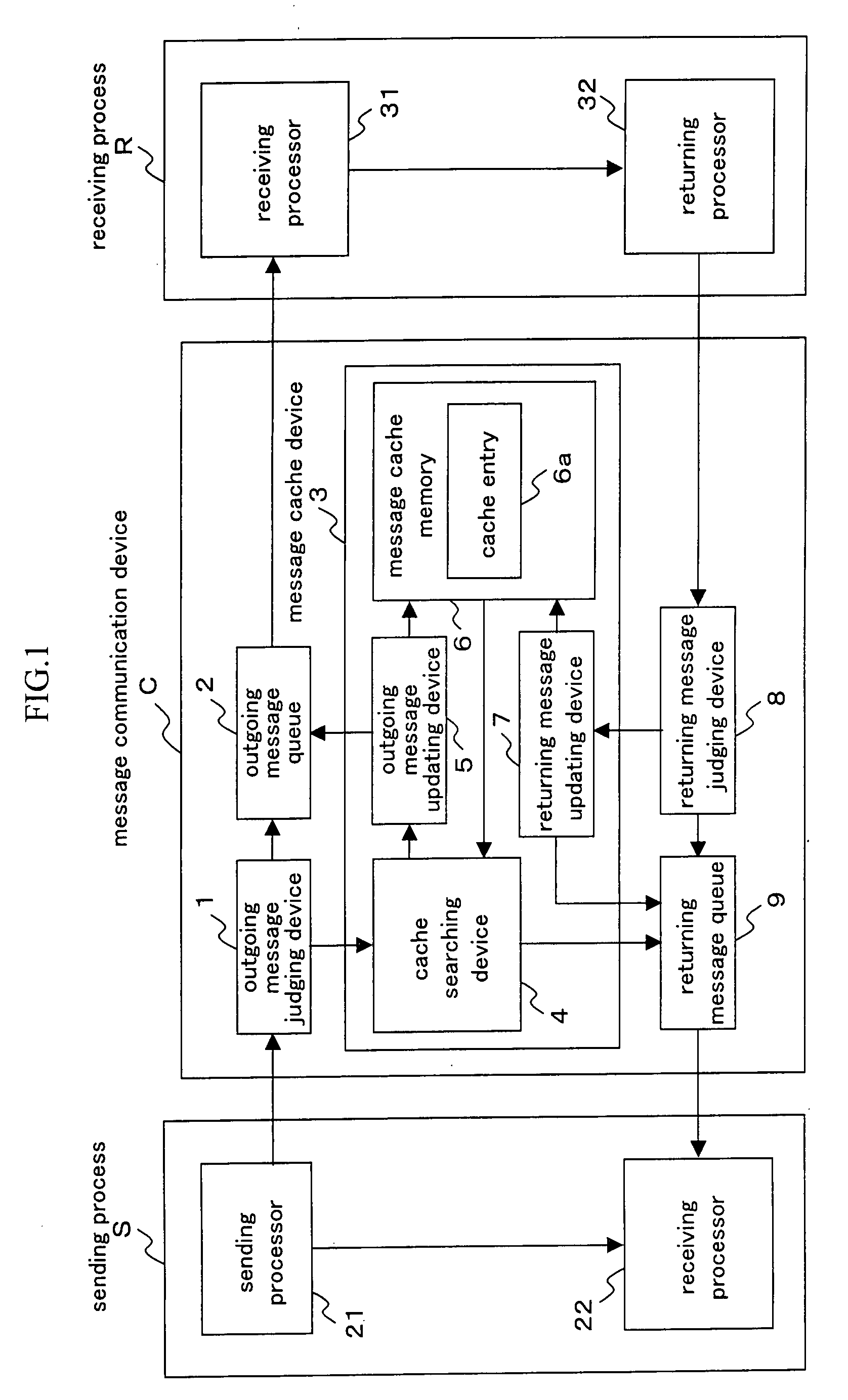Message communication device
a communication device and message technology, applied in the field of message communication devices, can solve the problems of affecting the performance of the device directly, the increase in process load will affect the device performance, and the response from the server process is delayed, so as to reduce the amount of signal processing in the device, the effect of facilitating the transmission/reception of messages and facilitating the processing
- Summary
- Abstract
- Description
- Claims
- Application Information
AI Technical Summary
Benefits of technology
Problems solved by technology
Method used
Image
Examples
first embodiments
[0060]FIG. 1 is a block diagram showing the constitution of a message communication device of a first embodiment of the present invention. The message communication device C of a first embodiment comprises an outgoing message judging device 1, an outgoing message queue 2, a message cache 3, returning message judging device 8 and returning message queue 9. The message cache 3 comprises a cache search device 4, outgoing message updating device 5, message cache memory 6 and returning message updating device 7. In addition, in the figure, S is a sending process, 21 is a sending processor, 22 is a receiving processor, R is a receiving process, 31 is a receiving processor and 32 is a returning processor.
[0061]The outgoing message judging device 1 judges if the message sent by the sending process S is cacheable or not. A cache is a means for shuffling a frequently used data into a high-speed processing device to speed up the process. When an outgoing message is judged to be noncacheable in...
second embodiments
[0075]FIG. 2 is a block diagram showing the constitution of a message communication device of a second embodiment of the present invention. In FIG. 2, the symbols similar as in the first embodiments (FIG. 1) denote the same components and their detailed explanations are omitted. The unique features of the second embodiments are as follows.
[0076]The outgoing message judging condition list L1 is a set of judging conditions for outgoing messages, and the outgoing message judging device 12 judges the outgoing messages based on the judging conditions in the message judging conditions list L1. The returning message judging condition list L2 is a set of judging conditions for returning messages, and the returning message judging device 13 judges returning messages based on the judging conditions in the message judging conditions list L2.
[0077]According to the embodiments, the outgoing message judging condition list L1 and returning message judging condition list L2 are set arbitrarily so a...
third embodiments
[0078]FIG. 3 is a block diagram showing the constitution of a message communication device of a third embodiment of the present invention. In FIG. 3, the symbols similar as in the first embodiments (FIG. 1) denote the same components and their detailed explanations are neglected. The unique features of the third embodiments are as follows.
[0079]The message communication device of a third embodiment comprises an outgoing message judging condition changer 10, returning message judging condition changer 11 and a third process P. The outgoing message judging condition changer 10 dynamically changes the contents of the set of outgoing message identifiers included in the outgoing message conditions. The returning message judging condition changer 11 dynamically changes the contents of the set of returning message identifiers included in the returning message conditions. The third process P drives the outgoing message judging condition changer 10 and the returning message judging condition...
PUM
 Login to View More
Login to View More Abstract
Description
Claims
Application Information
 Login to View More
Login to View More - R&D
- Intellectual Property
- Life Sciences
- Materials
- Tech Scout
- Unparalleled Data Quality
- Higher Quality Content
- 60% Fewer Hallucinations
Browse by: Latest US Patents, China's latest patents, Technical Efficacy Thesaurus, Application Domain, Technology Topic, Popular Technical Reports.
© 2025 PatSnap. All rights reserved.Legal|Privacy policy|Modern Slavery Act Transparency Statement|Sitemap|About US| Contact US: help@patsnap.com



